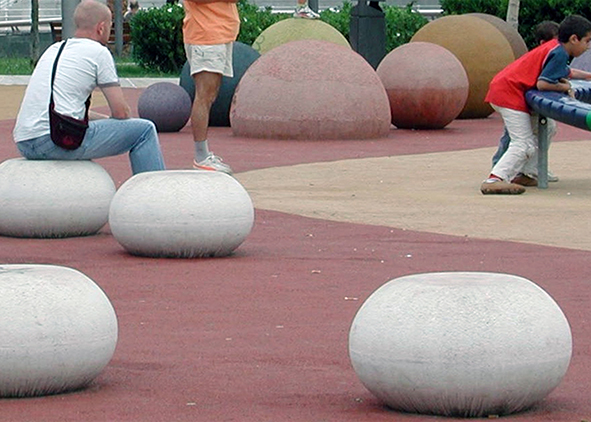High-Performance Concrete. Innovation and Supply Chain for Public Art and Urban Furniture
DOI:
https://doi.org/10.19229/2464-9309/5172019Keywords:
process innovation, compound, UHPC, multi-purpose, creative designAbstract
The current availability of UHPC (Ultra-High-Performance Concrete) concrete mixes with an adaptive and multi-performance behaviour has transformed the concept of ‘matter’ itself, allowing the construction of complex shapes and designs, and boosting the use of the compound in different sectors, thus opening new design paths following the concept of ‘non-standard’ in advanced neo-handicraft production processes. The results of technology research on the concrete compounds are analyzed in terms of how they have offered a type of mix that allows an expansion of the creative and ‘on-demand’ manufacturing process for self-supporting urban furniture and public art elements. The results and outlook of the supply chains are outlined in terms of performance, adjustment to standards, costs, network-building, and new market.
Downloads
Article Metrics Graph
References
Bader, T., Waldner, B. J., Unterberger, S. H. and Lacknerab, R. (2019), “On the performance of film formers versus penetrants as water-repellent treatment of High-Performance Concrete (HPC) surfaces”, in Construction and Building Materials, vol. 203, pp. 481-490.
Chen, Y., Matalkah, F., Rankothge, W., Balachandra, A. and Soroushian, P. (2017), “Improvement of the surface quality and aesthetics of ultra-high-performance concrete”, in Construction Materials | Proceedings of the Institution of Civil Engineers, pp. 1-10. [Online] Available at: www.icevirtuallibrary.com/doi/abs/10.1680/jcoma.17.00009 [Accessed 29 April 2019].
Corinaldesi, V. (2016), “Calcestruzzi ultraresistenti di ultima generazione”, in Coppola, L. (ed.), Temi di frontiera nella tecnologia e progettazione di strutture, American Concrete Institute Italy Chapter, GIC Italian Concrete Day, Proceedings, Piacenza.
Fehling, E., Bunje, K. and Leutbecher, T. (2004), “Design relevant properties of hardened Ultra High Performance Concrete”, in Schmidt, M., Geisenhanslüke, C. and Fehling, E. (eds), Proceeding of International Symposium on UHPC, 13-15 September 2004, Kassel, Kassel University Press, Kassel, pp. 327-338.
Harris, D. K. (2010), “Application of Ultra-High Performance Concrete (UHPC) for Sustainable Building Component”, in Sustainable Buildings – Materials and Energy Workshop, July 12-13, 2010, Technion, Haifa.
Henry, K. A. and Heaney, C. W. (2017), “Industrial production of thin rainscreen cladding in UHPC”, in AFGC-ACI-fib-RILEM International Symposium on Ultra-High Performance Fibre-Reinforced Concrete (UHPFRC 2017), 2-4 October 2017, Montpellier, France, pp. 937-944. [Online] Available at: www.afgc.asso.fr/images/stories/visites/BFUP-2017/Proceedings/pp937-944_Henry_Industrialized-Production-of-Thin-Rainscreen-Cladding-in-UHPC-June1.pdf [Accessed 3 March 2019].
Iori, T. and Poretti, S. (2012), “Ascesa e declino della Scuola italiana di ingegneria”, in Desideri, P., Demagistris, A., Olmo, C., Pogacnik, M. and Sorace, S. (eds), La Concezione Strutturale – Ingegneria e architettura in Italia negli anni cinquanta e sessanta, Allemandi, Torino, pp. 181-193.
Maspoli, R. (2016), The experimentation of UHPC in public art and urban furniture. [Online] Available at: www.cteit.org [Accessed 3 March 2019].
Möllmann, M. (2011), Dyckerhoff Weiss at BAU 2011, Buzzi Unicem. [Online] Available at: www.buzziunicem.it/web/guest/test-pg/-/document_library/gGqtBlCjOzUl/view_file/111915 [Accessed 22 February 2012].
Migayrou, F. (2004), Architectures non standard, Centre Pompidou, Paris.
National Precast Concrete Association (2014), Ultra High Performance Concrete – Guide to manufacturing architectural precast UHPC elements. [Online] Available at: precast.org/wp-content/uploads/2015/02/UHPC-White-Paper.pdf [Accessed 21 February 2019].
Negroponte, N. (1995), Essere digitali, Sperling & Kupfer Editori, Milano.
Noche, B. and Tarek, E. (2013), “Approach to innovative supply chain strategies in cement industry. Analysis and Model simulation”, in Procedia Social and Behavioral Sciences, n. 75, pp. 359-369.
Quiroga, P. N. and Fowler, D. W. (2004), The effects of aggregates characteristics on the performance of portland cement concrete, Research Report – Aggregates Foundation for Technology, Research and Education, The University of Texas at Austin, Austin. [Online] Available at: citeseerx.ist.psu.edu/viewdoc/download?doi=10.1.1.468.6998&rep=rep1&type=pdf [Accessed 10 April 2019].

Downloads
Published
How to Cite
Issue
Section
License
This Journal is published under Creative Commons Attribution Licence 4.0 (CC-BY).
License scheme | Legal code
This License allows anyone to:
Share: copy and redistribute the material in any medium or format.
Adapt: remix, transform, and build upon the material for any purpose, even commercially.
Under the following terms
Attribution: Users must give appropriate credit, provide a link to the license, and indicate if changes were made; users may do so in any reasonable manner, but not in any way that suggests the licensor endorses them or their use.
No additional restrictions: Users may not apply legal terms or technological measures that legally restrict others from doing anything the license permits.
Notices
Users do not have to comply with the license for elements of the material in the public domain or where your use is permitted by an applicable exception or limitation.
No warranties are given. The license may not give users all of the permissions necessary for their intended use. For example, other rights such as publicity, privacy, or moral rights may limit how you use the material.


















































































